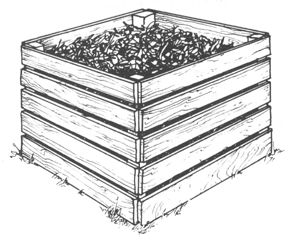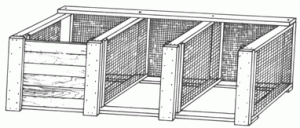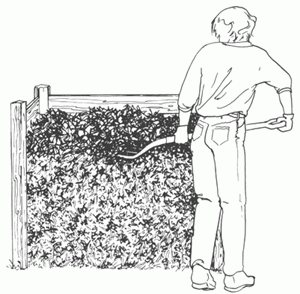Bulletin #1143, Home Composting
Reprinted with permission of the Seattle Engineering Department, Sold Waste Utility and the Seattle Tilth Association, Seattle, WA.
Updated by Nick Rowley, Sustainable Agriculture and Horticulture Professional, University of Maine Cooperative Extension.
For information about UMaine Extension programs and resources, visit extension.umaine.edu.
Find more of our publications and books at extension.umaine.edu/publications/.
Table of Contents:
- What is Compost?
- Why Should I Make Compost?
- What Can I Compost?
- How Can I Use Compost?
- The Essentials of Composting
- Composting Yard Wastes
- Vermicomposting
What is Compost?
Compost is the end product of a controlled aerobic decomposition process. Finished compost will be a homogeneous mix of indistinguishable material and will have a dark appearance, crumbly texture and earthy odor
Why Should I Make Compost?
Composting is a practical, convenient, and sustainable way to handle yard waste and other organic materials. It can be easier and cheaper than bagging these wastes or taking them to the landfill or transfer station. Compost is a valuable soil amendment that can improve your soil and promote plant growth. If you have a garden, a lawn, trees, shrubs, or even planter boxes. you have a use for compost.
By using compost, you return organic matter to the soil in a usable form. Organic matter in the soil improves plant growth by helping break heavy clay soils into a better texture, by adding water and nutrient-holding capacity to sandy soils, and by adding essential nutrients to any soil. Improving your soil is the first step toward improving the health of your plants.
What Can I Compost?
Anything that was once alive can be composted. Yard wastes, such as fallen leaves, grass clippings, weeds and the remains of garden plants, make excellent compost. However, larger wood material will not decompose quickly and homeowners may find reducing the size of the material helpful. Otherwise woody yard wastes can be clipped and sawed to a size useful for the wood stove or fireplace, or they can be run through a shredder for mulching and path making. Used as a mulch or for paths, they will eventually decompose.
Care must be taken when composting kitchen scraps. Compost them only by the methods outlined in this brochure. Meat, bones, and fatty foods (such as cheese, salad dressing, and leftover cooking oil) should be put in the garbage. While these can be composted, it is not recommended to do this at home due to animal vectors, odors, and potential health issues.
How Can I Use Compost?
Compost can be used to enrich the flower and vegetable garden, to improve the soil around trees and shrubs, as a soil amendment for houseplants and planter boxes and, when screened, as part of a seed-starting mix or lawn top dressing. It is recommended by the University of Maine that any compost should not fill more than 1/3 of growing containers.
The Essentials of Composting
With these principles in mind, everyone can make excellent use of their organic waste.
Biology
The compost pile is a complex ecosystem with billions of microorganisms serving various roles in the decomposition process. Bacteria are the most numerous in compost, and populations shift as the compost works through different phases. These bacteria use enzymes to break down organic materials chemically and do the majority of the decomposing. Actinomycetes are fungi-like bacteria that are responsible for the degradation of complex organic materials. These white connecting filaments can often be seen in successful compost piles. Fungi are present throughout the entire process and aid in breaking woody materials such as fibers, cellulose, and lignin. Other microorganisms, such as protozoans and rotifers, are found within water in these piles and play more of a secondary role in feeding on fungi and bacteria. Macroinvertebrates such as earthworms, centipedes, beetles, and others are also present and further break down organic material and feed upon other organisms in the pile after initial decomposition has taken place.
Materials
Anything growing in your yard is potential food for these tiny decomposers. Carbon and nitrogen from the cells of dead plants and dead microbes fuel their activity. The microorganisms use the carbon in leaves or woodier wastes as an energy source. Nitrogen provides the microbes with the raw element of proteins to build their bodies.
Everything organic has a ratio of carbon to nitrogen (C:N) in its tissues, ranging from 500:1 or more for woody material such as sawdust, to 15:1 for table scraps or 5:1 for some manures. Generally, C:N ratio of 30:1 is ideal for the activity of compost microbes. While exact C:N ratios for feedstocks are dependent on many things, for a simple home compost recipe, this balance can be achieved by mixing two parts grass clippings (which have a C:N ratio of 20:1) with one part fallen leaves (60:1) in your compost. Layering can be useful in arriving at these proportions, but a complete mixing of ingredients is preferable for the composting process. Other materials can also be used, such as weeds, garden or food wastes. Though the C:N ratio of 30:1 is ideal for a fast, hot compost, a higher ratio (i.e., 50:1) will be adequate for a slower compost.
Surface Area
The more surface area the microorganisms have to work on, the faster the materials are decomposed. It’s like a block of ice in the sun—slow to melt when it’s large but melting very fast when broken into smaller pieces. Chopping your garden wastes with a shovel or machete or running them through a shredding machine or lawnmower will speed up their composting. However, if the particle size of feedstocks in the compost pile becomes too small and numerous, airflow reduction could lead to poor composting.
Volume
A large compost pile will insulate itself and hold the heat of microbial activity. Its center will be warmer than its edges. Piles smaller than three feet cubed (27 cu. ft.) will have trouble holding this heat, while piles larger than five feet cubed (125 cu. ft.) may not allow enough air to reach the microbes at the center if the compost feedstocks do not provide enough porosity. These proportions are of importance only if your goal is a fast, hot compost.
Moisture and Aeration
All life on Earth needs a certain amount of water and air to sustain itself. The microbes in the compost pile are no different. They function best when the compost materials are about as moist as a wrung-out sponge and are provided with many air passages. Extremes of sun or rain can adversely affect this moisture balance in your pile. Generally speaking, we are looking for a moisture composition of roughly 50-60% and we need enough porosity in our piles to allow oxygen into the compost.
Time and Temperature
The faster the composting, the hotter the pile. If you use materials with a proper C:N ratio, provide a large amount of surface area and a big enough volume, and see that moisture and aeration are adequate, you will have a hot, fast compost (hot enough to burn your hand!) and will probably want to use the turning unit discussed in the next section. If you want to deal with your yard waste in an inexpensive, easy, nonpolluting way, the holding unit (also discussed in the next section) will serve you well. Ultimately, consider what your goal for composting is, as this will influence your management decisions.
Composting Yard Wastes
Holding Units

These simple containers for organic wastes are the least labor and time-consuming way to compost.
Which Wastes? Place the holding unit where it is most convenient. As weeds, grass clippings, leaves, and harvest remains from garden plants are collected, they can be dropped into the unit. Chopping or shredding wastes, alternating high-carbon and high-nitrogen materials, and keeping good moisture and aeration will all speed up the process. Although it may be tempting to place a compost bin close to your house, it can attract animals such as rodents and is not recommended.
Advantages and disadvantages: This is the simplest method for yard waste. The units are portable and can be moved wherever needed in the garden. Composting organic materials using this method can take six months to two years, so you only need to be patient.
Variations: Holding units can be made of circles of hardware cloth, old wooden pallets or wood and wire. It is important for any container to have a way to hold the material while also allowing air to flow through.
Turning Units

This is a series of three or more bins that allows wastes to be turned on a regular schedule. Turning units are most appropriate for gardeners with a large volume of yard waste and the desire to make a high-quality compost.
Which wastes? Nonwoody yard wastes are appropriate. Kitchen wastes without meat, bones or fatty foods can be added to the center of a pile if it is turned regularly and reaches high temperatures.
How? Alternate the layering of high-carbon and high-nitrogen materials to approximately a 30:1 ratio. These should be moistened to the damp sponge stage. The pile temperature should be checked regularly. When the heat decreases substantially, turn the pile into the next bin. Dampen the materials if they are not moist and add more high-nitrogen material if heating is not occurring. Then, make a new pile in the original bin. Repeat the process each time the pile in the first bin cools. After two weeks in the third bin, the compost should be ready for garden use.
Advantages and disadvantages: This method produces high-quality compost in a short time and utilizes a substantial labor input.
Variations: The unit can be built of wood, a combination of wood and wire, or a concrete block. Another turning unit type is the barrel composter, which tumbles the wastes for aeration.
The following troubleshooting chart is a guide to more efficient composting using a turning unit.
| Symptoms | Problem | Solution |
|---|---|---|
| The compost has a bad odor. | Not enough air/too much water. | Turn it. If needed, add course carbon source. |
| The center of the pile is dry. | Not enough water. | Moisten materials while turning the pile. |
| The compost is damp and warm in the middle, but nowhere else. | Too small. | Collect more material and mix the old ingredients into a new pile. |
| The heap is damp and sweet-smelling but still will not heat up. | Lack of nitrogen. | Mix in a nitrogen source like fresh grass clippings, fresh manure, blood-meal or ammonium sulfate. |
Mulching
Yard wastes can be used for weed control and water retention.
Which wastes? Woody yard wastes, leaves, and grass clippings.
How? You can spread leaves or grass clipping beneath plantings. For woody materials up to a few inches in diameter, rent or purchase a chipper/shredder. If they are in your neighborhood, some tree services often will deliver wood chips for free.
Advantages and disadvantages: All yard wastes will work first as a mulch and then, as decomposition proceeds, as a soil enrichment. A disadvantage of mulching with woody yard wastes is that you may have to buy or rent power equipment or make arrangements with a tree service. There are chip drop services that you can sign up for, but availability, quality, and delivery of materials are uncertain.
Variations: Use chipped materials for informal garden paths.
Vermicomposting (Earthworm Compost)
Vermicomposting or worm composting is a method of decomposing organic materials through the digestion of worms.
Feeding earthworms in wooden bins is a good way to make high-quality compost from food scraps.
Which wastes? Kitchen scraps without meat, bones, or fatty foods.
How? Fill a bin with moistened bedding such as peat moss or shredded paper for the worms. Rotate the burying of food wastes throughout the worm bin. The worm population should be divided every three to six months to fresh bedding.
Advantages and disadvantages: This is an efficient way to convert food waste into high-quality soil for houseplants, seedling transplants, or general garden use. The worms themselves are a useful product for fishing. There are costs associated with worm composting and additional labor considerations.
Variation: A stationary outdoor bin can be used in all but the coldest months or a portable indoor/outdoor bin can be used year-round.
Additional Resources
Vermicomposting NC State Extension
Vermicomposting Rodale Institute
illustrations reproduced with permission from Composting to Reduce the Waste Stream: A Guide to Small Scale Food and Yard Waste Composting (NRAES-43). Natural Resource, Agriculture, and Engineering Service (www.nraes.org), P.O. Box 4557, Ithaca, NY 148532-4557.
Information in this publication is provided purely for educational purposes. No responsibility is assumed for any problems associated with the use of products or services mentioned. No endorsement of products or companies is intended, nor is criticism of unnamed products or companies implied.
© 2003, 2025
Call 800.287.0274 (in Maine), or 207.581.3188, for information on publications and program offerings from University of Maine Cooperative Extension, or visit extension.umaine.edu.
In complying with the letter and spirit of applicable laws and pursuing its own goals of diversity, the University of Maine System does not discriminate on the grounds of race, color, religion, sex, sexual orientation, transgender status, gender, gender identity or expression, ethnicity, national origin, citizenship status, familial status, ancestry, age, disability physical or mental, genetic information, or veterans or military status in employment, education, and all other programs and activities. The University provides reasonable accommodations to qualified individuals with disabilities upon request. The following person has been designated to handle inquiries regarding non-discrimination policies: Director of Equal Opportunity and Title IX Services, 5713 Chadbourne Hall, Room 412, University of Maine, Orono, ME 04469-5713, 207.581.1226, TTY 711 (Maine Relay System).


